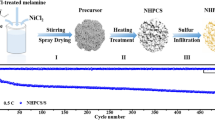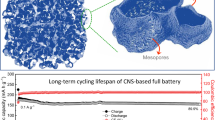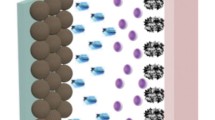Abstract
Lithium-ion capacitors (LICs) are gradually emerging as one of the most indispensable hybrid energy storage devices. However, it is one main challenge to evade the mismatch of electrochemical kinetics and specific capacity between cathode and anode in LICs. Herein, we have proposed an efficient strategy to prepare the nitrogen-doped hierarchical porous carbon spheres (NHPCS) as cathode, which is synthesized by a simple aerosol-spraying pyrolysis using the low-cost phenolic resin as carbon source without any other catalyst or hard template. The NHPCS exhibits porous nanospheres structure with an appropriate nitrogen doping level (3.65 at.%). Benefitting from the two-pronged strategy of N-doped feature and nanostructure engineering, NHPCS achieves a high specific capacity of 74 mAh g−1 at a current density of 0.1 A g−1 and remains 86.5% of initial capacity even being subjected to a high rate of 50-fold. Furthermore, a high-performance LIC has been developed by coupling NHPCS cathode and hard carbon anode, which delivers a maximum energy density of 151 Wh kg−1 and excellent cycle stability (96.3% capacity retention after 3000 cycles). Significantly, such designed porous carbon could not only be convenient for scalable production, but also be served for many other energy storage devices.
Graphic abstract
We have presented a larger-scale spray pyrolysis strategy to prepare nitrogen-doped hierarchical porous carbon spheres (NHPCS). A high-stable lithium-ion capacitor has been constructed by coupling NHPCS cathode with hard carbon anode, which exhibits a maximum energy density of 151 Wh kg−1 and capacity retention of 96.3% over 3000 cycles, showing great potential for the next-generation energy storage application.








Similar content being viewed by others
References
Simon P, Gogotsi Y (2008) Materials for electrochemical capacitors. Nat Mater 7:320–329
Shen L, Lv H, Chen S, Kopold P, Aken PA, Wu X, Maier J, Yu Y (2017) Peapod-like Li3VO4/N-doped carbon nanowires with pseudocapacitive properties as advanced materials for high-energy lithium-ion capacitors. Adv Mater 29:1700142
Ye L, Liang Q, Lei Y, Yu X, Han C, Shen W, Huang ZH, Kang F, Yang QH (2015) A high performance Li-ion capacitor constructed with Li4Ti5O12/C hybrid and porous graphene macroform. J Power Sources 282:174–178
Ma C, Zhao Y, Li J, Song Y, Shi J, Guo Q, Liu L (2013) Synthesis and electrochemical properties of artificial graphite as an anode for high-performance lithium-ion batteries. Carbon 64:553–556
Kim J-H, Kim J-S, Lim Y-G, Lee J-G, Kim Y-J (2011) Effect of carbon types on the electrochemical properties of negative electrodes for Li-ion capacitors. J Power Sour 196:10490–10495
Shao Y, El-Kady MF, Sun J, Li Y, Zhang Q, Zhu M, Wang H, Dunn B, Kaner RB (2018) Design and mechanisms of asymmetric supercapacitors. Chem Rev 118:9233–9280
Chen Z, Li H, Lu X, Wu L, Jiang J, Jiang S, Wang J, Dou H, Zhang X (2018) Nitrogenated urchin-like Nb2O5 microspheres with extraordinary pseudocapacitive properties for lithium-ion capacitors. ChemElectroChem 5:1516–1524
Jiang J, Zhang Y, An Y, Wu L, Zhu Q, Dou H, Zhang X (2019) Engineering ultrathin MoS2 nanosheets anchored on N-Doped carbon microspheres with pseudocapacitive properties for high-performance lithium-ion capacitors. Small Methods 3:1900081
Gogotsi Y, Nikitin A, Ye H, Zhou W, Fischer JE, Yi B, Foley H, Barsoum MW (2012) Nanoporous carbide-derived carbon with tunable pore size. Nat Mater 2:591–594
Largeot C, Portet C, Chmiola J, Taberna PL, Gogotsi Y, Simon P (2008) Relation between the ion size and pore size for an electric double-layer capacitor. J Am Chem Soc 130:2730–2731
Wang J, Shen L, Nie P, Yun X, Xu Y, Dou H, Zhang X (2015) N-doped carbon foam based three-dimensional electrode architectures and asymmetric supercapacitors. J Mater Chem A 3:2853–2860
Wang R, Lang J, Zhang P, Lin Z, Yan X (2015) Fast and large lithium storage in 3D porous VN nanowires-graphene composite as a superior anode toward high-performance hybrid supercapacitors. Adv Funct Mater 25:2270–2278
Wang J, Kim J, Ding B, Kim JH, Malgras V, Young C, Yamauchi Y (2019) Ultra-thin, highly graphitized carbon nanosheets into three-dimensional interconnected framework utilizing a ball mill mixing of precursors. Chem Eng J 374:1214–1220
Li Z, Xu Z, Tan X, Wang H, Holt C, Stephenson T, Olsen B, Mitlin D (2013) Mesoporous nitrogen-rich carbons derived from protein for ultra-high capacity battery anodes and supercapacitors. Energy Environ Sci 6:871–878
Wei J, Zhou D, Sun Z, Deng Y, Xia Y, Zhao D (2012) A controllable synthesis of rich nitrogen-doped ordered mesoporous carbon for CO2 capture and supercapacitors. Adv Funct Mater 23:2322–2328
Zheng F, Yang Y, Chen Q (2014) High lithium anodic performance of highly nitrogen-doped porous carbon prepared from a metal-organic framework. Nat Commun 5:5261
Wang Y, Wang C, Guo H, Wang Y, Huang Z (2017) A nitrogen-doped three-dimensional carbon framework for high performance sodium ion batteries. RSC Adv 7:1588–1592
Wang H, Zhang Y, Ang H, Zhang Y, Tan HT, Zhang Y, Guo Y, Franklin JB, Wu XL, Srinivasan M, Fan HJ, Yan Q (2016) A high-energy lithium-ion capacitor by integration of a 3D interconnected titanium carbide nanoparticle chain anode with a pyridine-derived porous nitrogen-doped carbon cathode. Adv Funct Mater 26:3082–3093
Du J, Liu L, Wu H, Chen A (2019) N-doped yolk-shell carbon nanotube composite for enhanced electrochemical performance in a supercapacitor. Nanoscale 11:22796–22803
Li Y, Wang G, Wei T, Fan Z, Yan P (2016) Nitrogen and sulfur co-doped porous carbon nanosheets derived from willow catkin for supercapacitors. Nano Energy 19:165–175
Yang C, Li W, Yang Z, Gu L, Yu Y (2015) Nanoconfined antimony in sulfur and nitrogen co-doped three-dimensionally (3D) interconnected macroporous carbon for high-performance sodium-ion batteries. Nano Energy 18:12–19
Jiang J, Nie P, Fang S, Zhang Y, An Y, Fu R, Dou H, Zhang X (2018) Boron and nitrogen dual-doped carbon as a novel cathode for high performance hybrid ion capacitors. Chin Chem Lett 29:624–628
Zhu J, He C, Li Y, Kang S, Shen PK (2013) One-step synthesis of boron and nitrogen-dual-self-doped graphene sheets as non-metal catalysts for oxygen reduction reaction. J Mater Chem A 1:14700–14705
Xia Q, Yang H, Wang M, Yang M, Guo Q, Wan L, Xia H, Yu Y (2017) High energy and high power lithium-ion capacitors based on boron and nitrogen dual-doped 3D carbon nanofibers as both cathode and anode. Adv Energy Mater 7:1701336
Beguin F, Szostak K, Lota G, Frackowiak E (2005) A self-supporting electrode for supercapacitors prepared by one-step pyrolysis of carbon nanotube/polyacrylonitrile blends. Adv Mater 17:2380–2384
Chen Y, Zhang X, Zhang D, Yu P, Ma Y (2011) High performance supercapacitors based on reduced graphene oxide in aqueous and ionic liquid electrolytes. Carbon 49:573–580
Jeong HM, Lee JW, Shin WH, Choi YJ, Shin HJ, Kang JK, Choi JW (2011) Nitrogen-doped graphene for high-performance ultracapacitors and the importance of nitrogen-doped sites at basal planes. Nano Lett 11:2472–2477
Li B, Dai F, Xiao Q, Yang L, Shen J, Zhang C, Cai M (2016) Nitrogen-doped activated carbon for a high energy hybrid supercapacitor. Energy Environ Sci 9:102–106
Raymundo-Pinero E, Cadek M, Beguin F (2009) Tuning carbon materials for supercapacitors by direct pyrolysis of seaweeds. Adv Funct Mater 19:1032–1039
Jia Q, Yang C, Pan Q, Xin Y, Xu F, Qi W, Wei H, Yang S, Zhou C, Hu N, Cao B (2020) High-voltage aqueous asymmetric pseudocapacitors based on methyl blue-doped polyaniline hydrogels and the derived N/S-codoped carbon aerogels. Chem Eng J 383:123153
Wang C, Wang F, Liu Z, Zhao Y, Liu Y, Yue Q, Zhu H, Deng Y, Wu Y, Zhao D (2017) N-doped carbon hollow microspheres for metal-free quasi-solid-state full sodium-ion capacitors. Nano Energy 41:674–680
Qiu D, Gao A, Xie Z, Zheng L, Kang C, Li Y, Guo N, Li M, Wang F, Yang R (2018) Homologous hierarchical porous hollow carbon spheres anode and bowls cathode enabling high-energy sodium-ion hybrid capacitors. ACS Appl Mater Interfaces 10:44483–44493
Leng J, Wang Z, Wang J, Wu HH, Yan G, Li X, Guo H, Liu Y, Zhang Q, Guo Z (2019) Advances in nanostructures fabricated via spray pyrolysis and their applications in energy storage and conversion. Chem Soc Rev 48:3015–3072
Moreno-Fernández G, Gómez-Urbano JL, Enterría M, Rojo T, Carriazo D (2019) Flat-shaped carbon–graphene microcomposites as electrodes for high energy supercapacitors. J Mater Chem A 7:14646–14655
Zhang F, Zhang T, Yang X, Zhang L, Leng K, Huang Y, Chen Y (2013) A high-performance supercapacitor-battery hybrid energy storage device based on graphene-enhanced electrode materials with ultrahigh energy density. Energy Environ Sci 6:1623–1632
Chen CM, Zhang Q, Yang MG, Huang CH, Yang YG, Wang MZ (2012) Structural evolution during annealing of thermally reduced graphene nanosheets for application in supercapacitors. Carbon 50:3572–3584
Li Z, Xu Z, Wang H, Ding J, Zahiri B, Holt CMB, Tan X, Mitlin D (2014) Colossal pseudocapacitance in a high functionality-high surface area carbon anode doubles the energy of an asymmetric supercapacitor. Energy Environ Sci 7:1708–1718
Jiang J, Yuan J, Nie P, Zhu Q, Chen C, He W, Zhang T, Dou H, Zhang X (2020) Hierarchical N-doped hollow carbon microspheres as advanced materials for high-performance lithium-ion capacitors. J Mater Chem A 8:3956–3966
Wang C, Wang X, Lu H, Li H, Zhao XS (2018) Cellulose-derived hierarchical porous carbon for high-performance flexible supercapacitors. Carbon 140:139–147
Xu SW, Zhao YQ, Xu YX, Chen QH, Zhang GQ, Xu QQ, Zhao DD, Zhang X, Xu CL (2018) Heteroatom doped porous carbon sheets derived from protein-rich wheat gluten for supercapacitors: the synergistic effect of pore properties and heteroatom on the electrochemical performance in different electrolytes. J Power Source 401:375–385
Li Z, Cao L, Chen W, Huang Z, Liu H (2019) Mesh-like carbon nanosheets with high-level nitrogen doping for high-energy dual-carbon lithium-ion capacitors. Small 15:1805173
Ania CO, Khomenko V, Raymundo-Pinero E, Parra JB, Beguin F (2007) The large electrochemical capacitance of microporous doped carbon obtained by using a zeolite template. Adv Funct Mater 17:1828–1836
Pandolfo AG, Hollenkamp AF (2006) Carbon properties and their role in supercapacitors. J Power Sources 157:11–27
Silva R, Voiry D, Chhowalla M, Asefa T (2013) Efficient metal-free electrocatalysts for oxygen reduction: polyaniline-derived N- and O-doped mesoporous carbons. J Am Chem Soc 135:7823–7826
Biniaka S, Szymańskia G, Siedlewskia J, Świątkowskib A (1997) The characterization of activated carbons with oxygen and nitrogen surface groups. Carbon 35:1799–1810
Li C, Zhang X, Wang K, Sun X, Ma Y (2018) High-power and long-life lithium-ion capacitors constructed from N-doped hierarchical carbon nanolayer cathode and mesoporous graphene anode. Carbon 140:237–248
Li Z, Mi H, Bai Z, Ji C, Sun L, Gao S, Qiu J (2019) Sustainable biowaste strategy to fabricate dual-doped carbon frameworks with remarkable performance for flexible solid-state supercapacitors. J Power Sources 418:112–121
Li Z, Gao S, Mi H, Lei C, Ji C, Xie Z, Yu C, Qiu J (2019) High-energy quasi-solid-state supercapacitors enabled by carbon nanofoam from biowaste and high-voltage inorganic gel electrolyte. Carbon 149:273–280
Li Z, Chen N, Mi H, Ma J, Xie Y, Qiu J (2017) Hierarchical hybrids integrated by dual polypyrrole-based porous carbons for enhanced capacitive performance. Chemistry 23:13474–13481
Liang T, Wang H, Fei R, Wang R, He B, Gong Y, Yan C (2019) A high-power lithium-ion hybrid capacitor based on a hollow N-doped carbon nanobox anode and its porous analogue cathode. Nanoscale 11:20715–20724
Sun F, Liu X, Wu HB, Wang L, Gao J, Li H, Lu Y (2018) In situ high-level nitrogen doping into carbon nanospheres and boosting of capacitive charge storage in both anode and cathode for a high-energy 4.5 V full-carbon lithium-ion capacitor. Nano Lett 18:3368–3376
Jiang YQ, Liu JP (2019) Definitions of pseudocapacitive materials: a brief review. Energy Environ Mater 2:30–37
Aref A, Chen SW, Rajagopalan R, Randall C (2019) Bimodal porous carbon cathode and prelithiated coalesced carbon onion anode for ultrahigh power energy efficient lithium ion capacitors. Carbon 152:89–97
Sun L, Zhou H, Li L, Yao Y, Qu H, Zhang C, Liu S, Zhou Y (2017) Double soft-template synthesis of nitrogen/sulfur-codoped hierarchically porous carbon materials derived from protic ionic liquid for supercapacitor. ACS Appl Mater Interfaces 9:26088–26095
Jiang J, Zhang Y, Li Z, An Y, Zhu Q, Xu Y, Zang S, Dou H, Zhang X (2020) Defect-rich and N-doped hard carbon as a sustainable anode for high-energy lithium-ion capacitors. J Colloid Interface Sci 567:75–83
Wang H, Xu Z, Li Z, Cui K, Ding J, Kohandehghan A, Tan X, Zahiri B, Olsen BC, Holt CMB, Mitlin D (2014) Hybrid device employing three-dimensional arrays of MnO in carbon nanosheets bridges battery–supercapacitor divide. Nano Lett 14:1987–1994
Zhang J, Liu X, Wang J, Shi J, Shi Z (2016) Different types of pre-lithiated hard carbon as negative electrode material for lithium-ion capacitors. Electrochim Acta 187:134–142
Wang G, Lu C, Zhang X, Wan B, Liu H, Xia M, Gou H, Xin G, Lian J, Zhang Y (2017) Toward ultrafast lithium ion capacitors: a novel atomic layer deposition seeded preparation of Li4Ti5O12/graphene anode. Nano Energy 36:46–57
Yi R, Chen S, Song J, Gordin ML, Manivannan A, Wang D (2014) High-performance hybrid supercapacitor enabled by a high-rate Si-based anode. Adv Funct Mater 24:7433–7439
Li CY, Wu WZ, Wang P, Zhou WB, Wang J, Chen YH, Fu LJ, Zhu YS, Wu YP, Huang W (2019) Fabricating an aqueous symmetric supercapacitor with a stable high working voltage of 2 V by using an alkaline-acidic electrolyte. Adv Sci 6:1801665
Li CY, Wu WZ, Zhang SS, He L, Zhu YS, Wang J, Fu LJ, Chen YH, Wu YP, Huang W (2019) A high-voltage aqueous lithium ion capacitor with high energy density from an alkaline–neutral electrolyte. J Mater Chem A 7:4110–4118
Acknowledgements
This work was financially supported by the National Natural Science Foundation of China (U1802256, 51672128, 21773118, 21875107), the Key Research and Development Program in Jiangsu Province (BE2018122) and Project Funded by the Priority Academic Program Development of Jiangsu Higher Education Institutions (PAPD). Mr. Ziqian Yang would like to acknowledge the financial support from the Undergraduate Innovation and Entrepreneurship Training Program in NUAA (2019CX00602).
Author information
Authors and Affiliations
Corresponding author
Ethics declarations
Conflict of interest
The authors declare no conflict of interest.
Additional information
Publisher's Note
Springer Nature remains neutral with regard to jurisdictional claims in published maps and institutional affiliations.
Electronic supplementary material
Below is the link to the electronic supplementary material.
Rights and permissions
About this article
Cite this article
Xu, Y., Jiang, J., Li, Z. et al. Aerosol-assisted preparation of N-doped hierarchical porous carbon spheres cathodes toward high-stable lithium-ion capacitors. J Mater Sci 55, 13127–13140 (2020). https://doi.org/10.1007/s10853-020-04955-2
Received:
Accepted:
Published:
Issue Date:
DOI: https://doi.org/10.1007/s10853-020-04955-2




